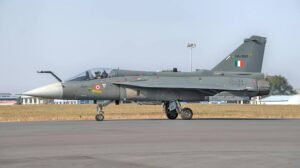Tejas Fighter Jet Crash in Dubai
|
General Studies Paper II: Indigenization of Technology, Defence |
Why in News?
Recently, an Indian Air Force Tejas fighter jet crashed during a demonstration flight at the Dubai Air Show. The incident occurred at Al Maktoum Airport while the aircraft was performing an aerial display.
Details of the Tejas Fighter Jet Crash in Dubai Air Show
- Incident: The crash occurred on 21 November 2025, the final day of the Dubai Air Show held at Al Maktoum International Airport. The Tejas aircraft, belonging to the Indian Air Force, was performing a demonstration flight when the incident happened. Videos shared on social media show the jet going into a steep descent and then erupting into a fireball, followed by thick black smoke. The pilot Wing Commander Namansh Syal, an experienced IAF flyer lost his life.
- Response: Immediately after the crash, firefighting and rescue teams rushed to the site and took necessary steps. The air show organisers suspended flight operations briefly. The IAF immediately announced the formation of a Court of Inquiry to investigate the crash.
- Possible Causes: Video analysis suggests that the jet may have lost stability while performing a negative-G turn or low-altitude roll. The aircraft might not have had sufficient altitude to recover from the maneuver before impact. Some analysts are considering whether the high humidity in Dubai could have played a role, given the standard water-draining process in the Tejas’ environmental control system.
- Investigation: The Court of Inquiry will likely examine aerodynamic control, specifically how the delta-wing design of Tejas behaves under extreme manoeuvres at low altitude. They will also look into the angle of attack at the time of the maneuver; loss of control during low-speed, high-G turns is a known risk. They will also verify maintenance logs, cockpit data, and whether sensor data or flight instrumentation delivered any warnings to the pilot.
|
Negative-G Turn
|
All About IAF Tejas Fighter Jet:
- About: The Tejas is a single engine light combat aircraft. Hindustan Aeronautics Limited (HAL) and Aeronautical Development Agency (ADA) designed the aircraft in India. The aircraft uses a delta wing layout and serves as a multirole fighter. The aircraft first flew on 4 January 2001 and entered service with the Indian Air Force in 2015. The aircraft aims to reduce dependence on foreign fighters.
- History: India began the light combat aircraft project in the 1980s. ADA led the design work and HAL built prototypes and production jets. Developers tested the aircraft over many years. Initial operational clearance came in 2011 and then the air force awarded expanded clearances in 2013. After this the first Tejas squadron became operational in 2016.
- Variants: The original production type is the Tejas Mark 1. The improved version is named Tejas Mk1A and the heavier design is called Tejas Mk2. Trainer versions exist as twin seat aircraft. The Mk1A adds an active electronically scanned array radar and a self protection jammer. In future, the Mk2 will carry more fuel and will have more weapon stations.
- Current Status: The Indian Air Force (IAF) currently has 38 Tejas aircraft in service, with an initial order of 40 (20 IOC and 20 FOC standard) not fully delivered yet. The IAF also has an order for 83 Tejas Mk1A aircraft and 10 trainer variants, and has recently placed a new order for 97 Tejas Mk1A jets. By the end of the decade, the IAF will have a total of 220 aircraft from these two large orders.
Features of the Tejas Fighter Jet
- Airframe and Structure: Tejas uses a compound delta wing design with no tailplane. The structure is lightweight, made from a mix of carbon-fibre composites, aluminium-lithium alloys, and titanium. About 45% of Tejas’ airframe by weight is composite material, which helps in agility and fuel efficiency.
- Flight Control System: Tejas has a quad-redundant digital fly-by-wire (FBW) system. This system has four independent computing channels. The FBW system uses data from multiple sensors — acceleration sensors, pilot stick, air-data sensors.
- Engine and Performance: The jet is powered by a GE F404-IN20 turbofan engine. This engine delivers strong thrust, giving the Tejas a good thrust-to-weight ratio. Tejas can reach a maximum speed of around Mach 1.6. It has a service ceiling of about 50,000 feet. It can carry drop tanks (up to 4,000 litres) on its hardpoints to extend its range.
- Cockpit, Avionics, and Display: The cockpit is a glass cockpit, compatible with night vision goggles (NVG). It has a Head-Up Display (HUD) developed by a domestic research organisation. There are multi-function displays (MFDs): Tejas has three 5″ × 5″ MFDs plus standby display units. It includes a “get-you-home” panel, which helps in emergencies and works with a fail-safe air-data computer. The cockpit also has a helmet-mounted display and sight (HMDS) and a hands-on throttle-and-stick (HOTAS) arrangement.
- Sensors, Radar, and Electronic Warfare: Early Tejas versions use a mechanical radar with multi-mode capabilities: searching, tracking, ground-mapping. The Mk 1A version features a modern AESA radar (e.g., EL/M-2052 or indigenous “Uttam” AESA), which improves target tracking. It has an Electronic Warfare (EW) suite that includes a Radar Warning Receiver (RWR), self-protection jammer, missile approach warner, and chaff/flare dispenser.
- Weapons and Payload: Tejas has nine external hardpoints (on wings and fuselage) to carry weapons. It carries a 23 mm twin-barrel GSh-23 cannon, with a high firing rate. The jet can deploy air-to-air missiles like R-73 and beyond-visual-range (BVR) missiles such as Astra. It can also carry precision-guided bombs, rockets, and anti-ship weapons. It supports electronic countermeasure (ECM) pods, surveillance pods, and targeting pods depending on mission needs.
- Stealth and Survivability: Tejas reduces detectability via its low radar-cross-section (RCS). Its bifurcated (Y-shaped) intake helps hide the engine fan blades, which reduces its radar signature. The use of composites not only lowers weight but also improves durability and reduces corrosion.
- On-Board Oxygen and Endurance Systems: An On-Board Oxygen Generation System (OBOGS) is integrated (in more advanced variants), which allows for long missions and negates need for stored liquid oxygen. The aircraft supports mid-air refuelling in upgraded versions, increasing mission endurance.
- Reliability and Safety: The flight control computer uses redundant architecture which enhances flight safety. Modular components make maintenance faster and turnaround time lower. The health-monitoring system tracks key parameters of aircraft systems in-flight.
Strategic Significance of Tejas
- Indigenous Defence Base: The Tejas plays a critical role in India’s pursuit of defence self-reliance (“Atmanirbhar Bharat”). By producing a modern light combat aircraft domestically, India reduces its dependence on foreign suppliers for frontline fighters. This builds long-term strategic autonomy in the aerospace domain while strengthening the indigenous defence industrial base.
- Strengthen IAF: Tejas addresses a growing squadron strength gap in the Indian Air Force (IAF). As legacy aircraft like the MiG-21 are phased out, Tejas brings in fresh, modern capability to maintain the IAF’s combat strength. The order for 97 more Mk-1A Tejas jets underscores this urgency.
- Geopolitical Deterrence: The fighter jet enhances geopolitical deterrence in the region. As a light, agile multirole aircraft, Tejas can operate in both defensive and strike roles. Its deployment raises India’s readiness vis-à-vis adversaries like China and Pakistan, especially in contested airspace or limited-intensity conflicts.
- Defence Export: Tejas also acts as a cornerstone for India’s defence export ambitions. The Mk-1A’s advanced systems, such as the Uttam AESA radar, make it competitive globally. Analysts consider it capable of surpassing regional rivals like the JF-17 in the light combat aircraft market.
- PPP Model Support: Tejas strengthens public-private partnership in defence manufacturing. Key subassemblies now come from Indian private firms, increasing supply chain resilience and reducing reliance on single vendors.
|
Also Read: India’s HAL- GE Aerospace Deal for Tejas Light Combat Aircraft Programme |









